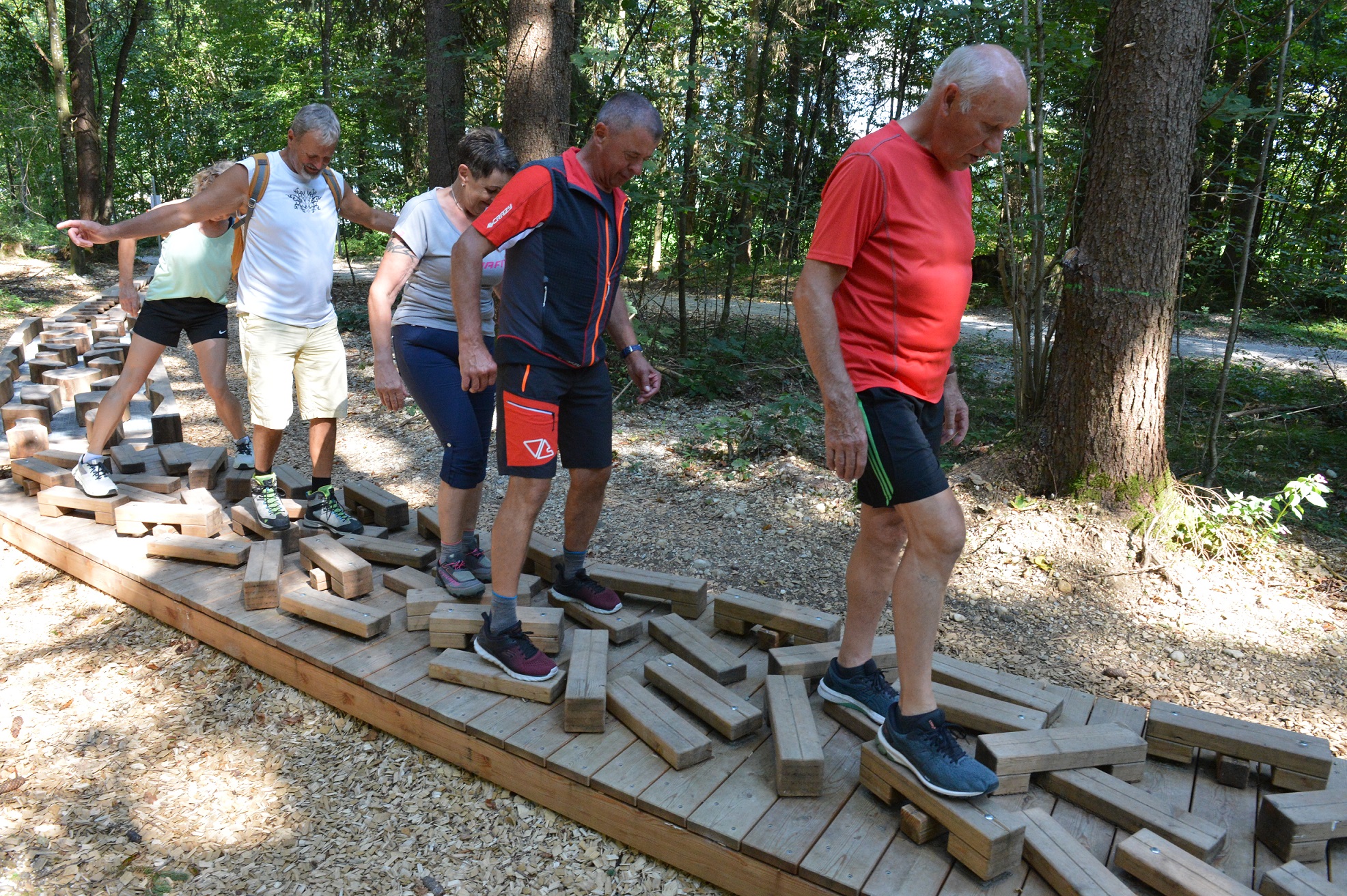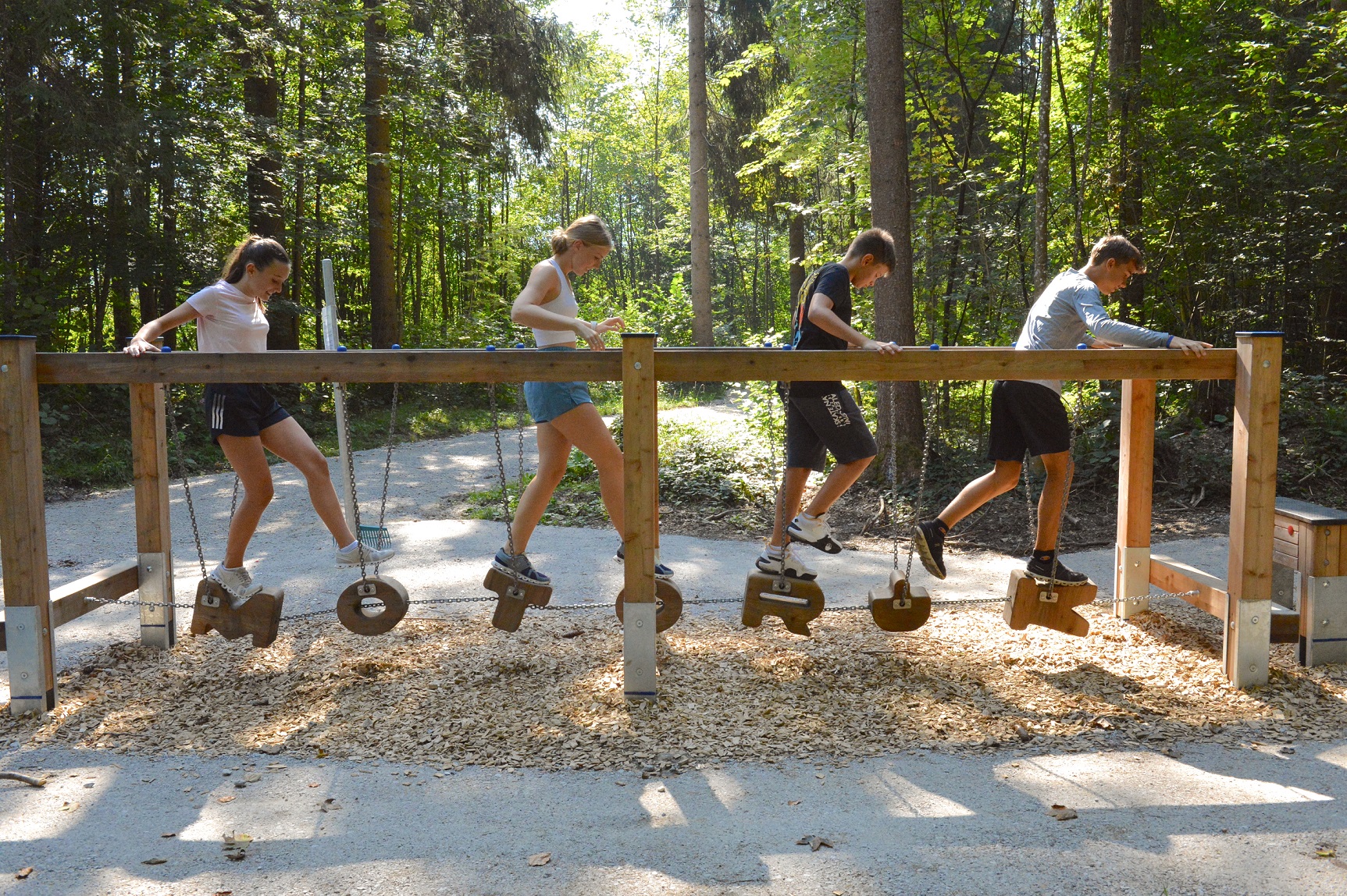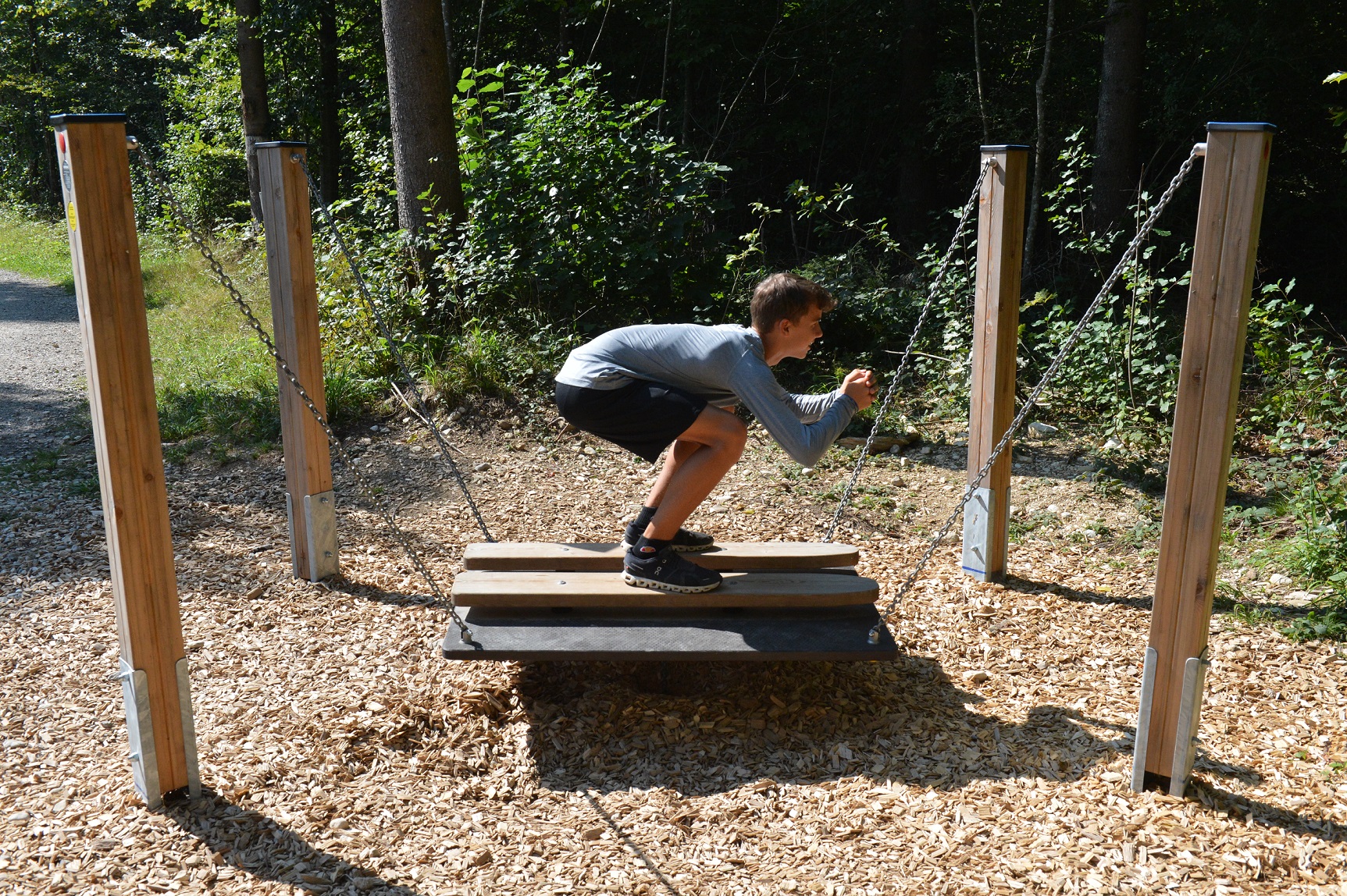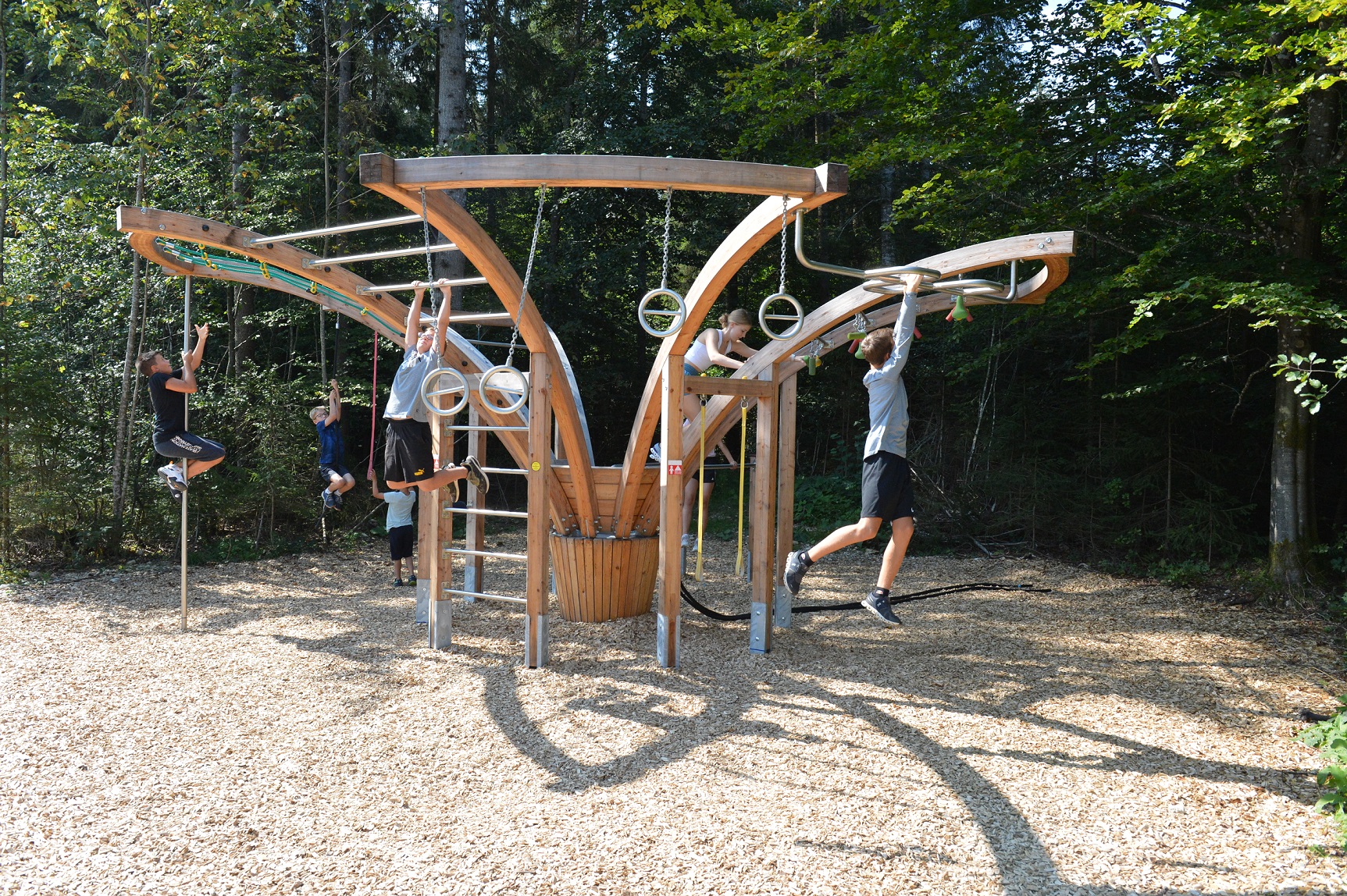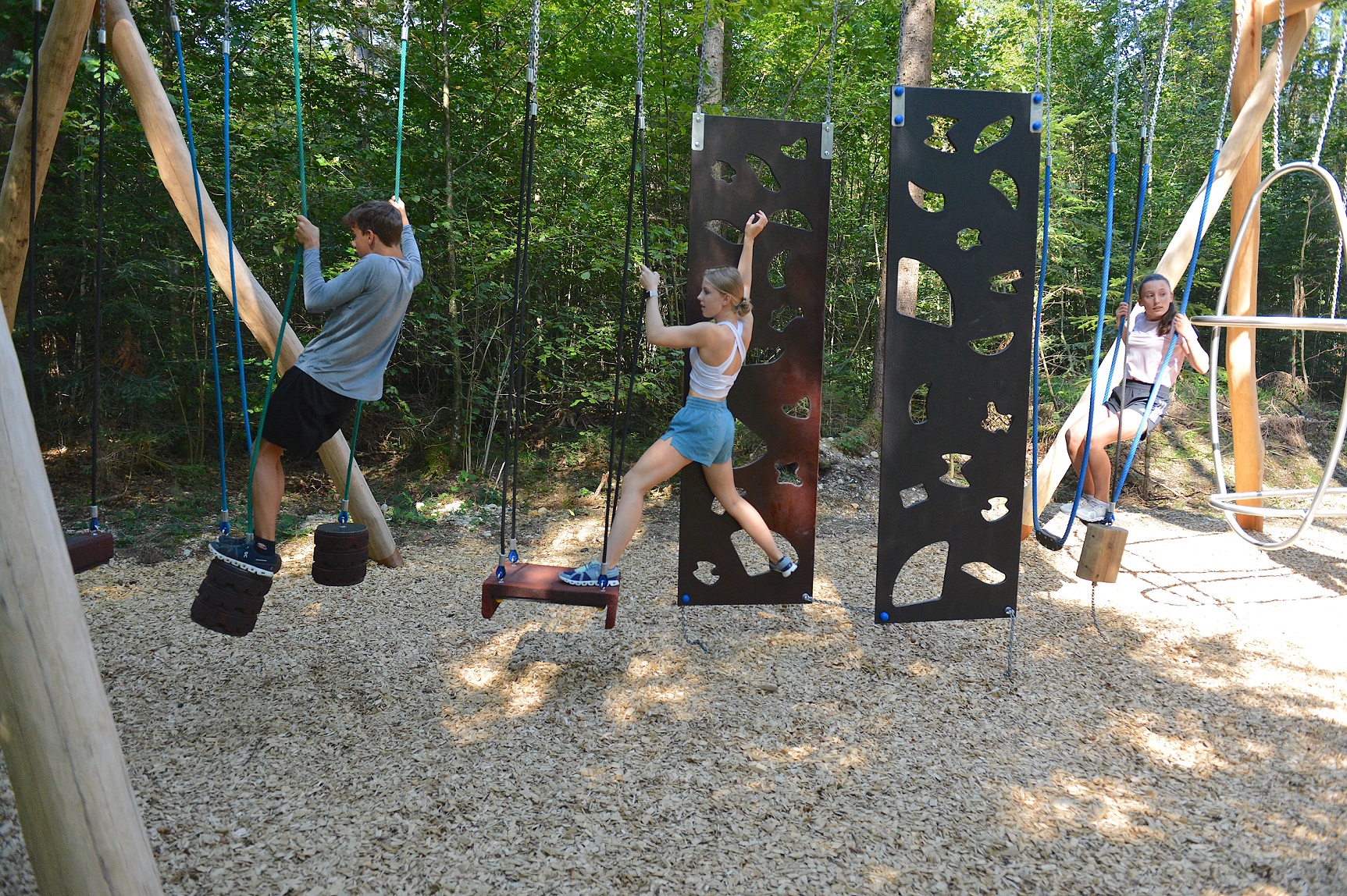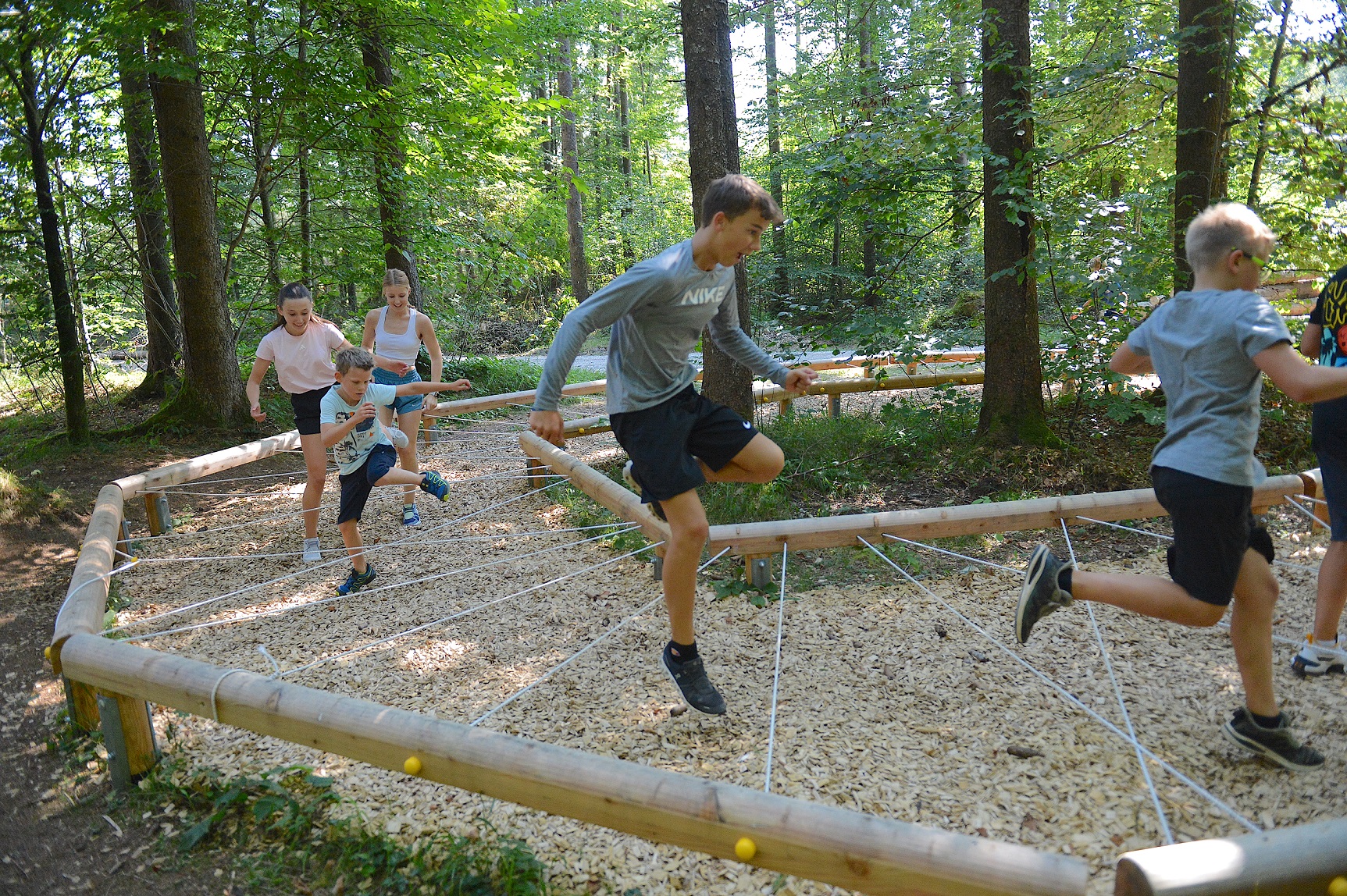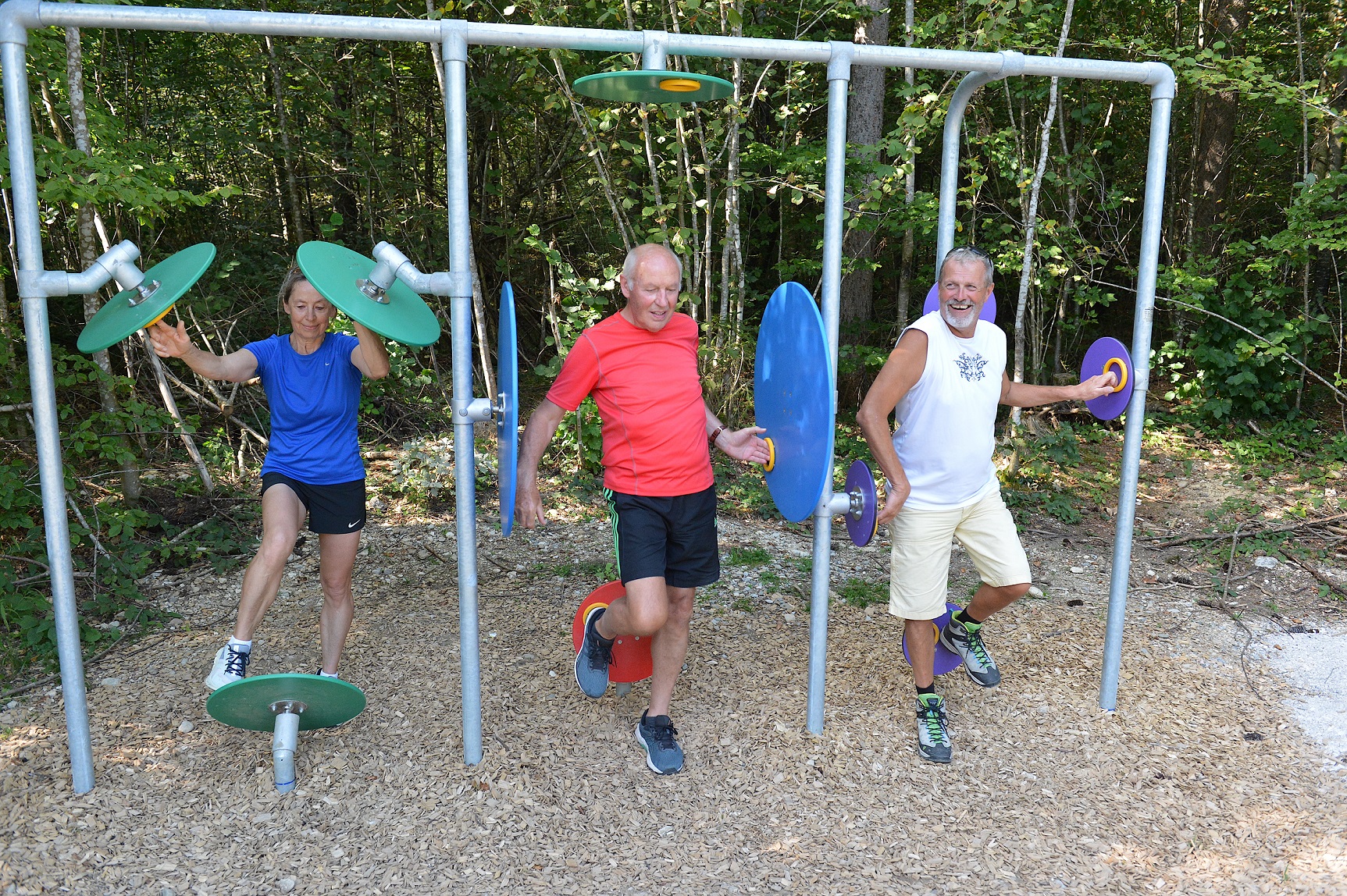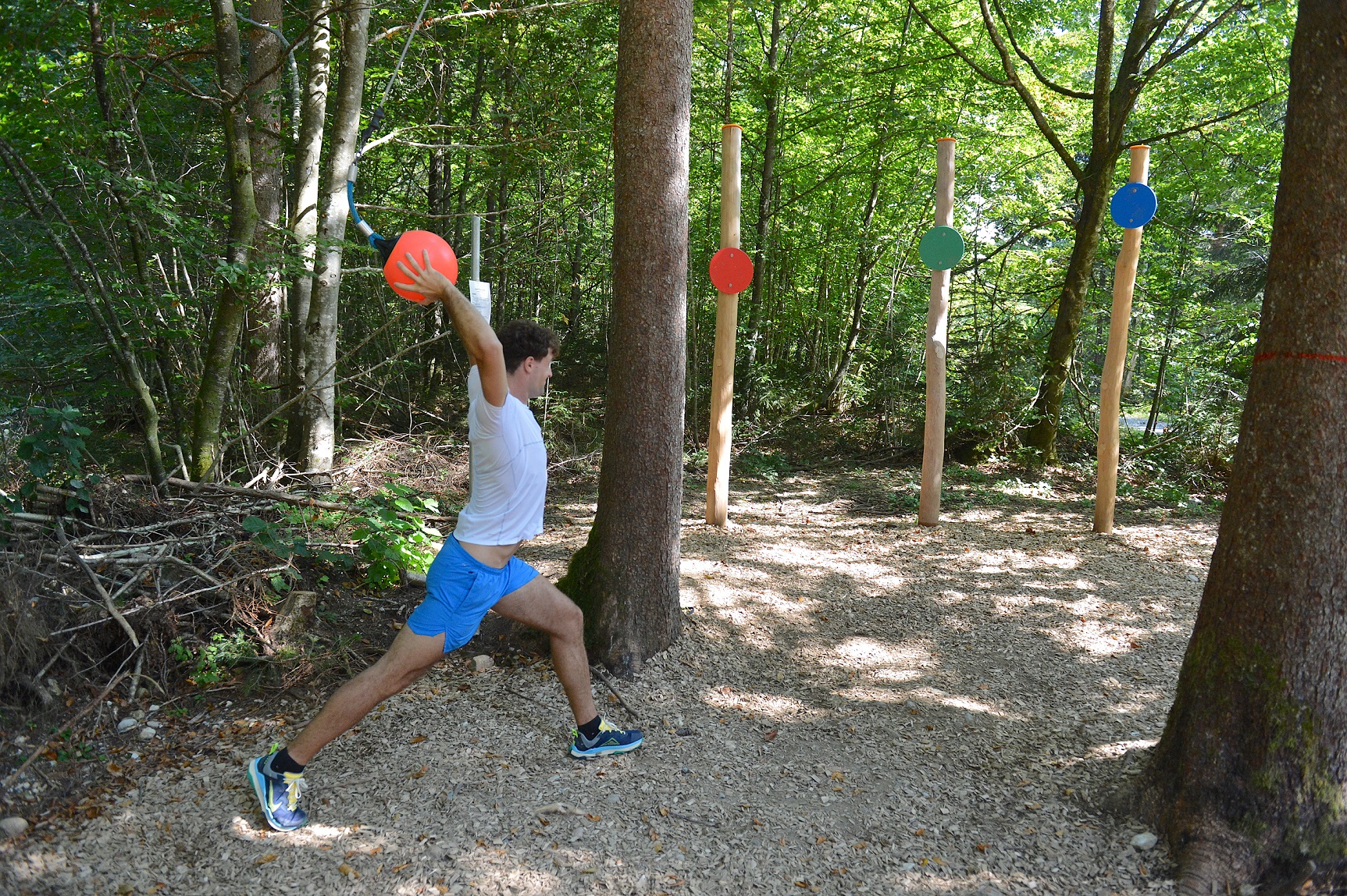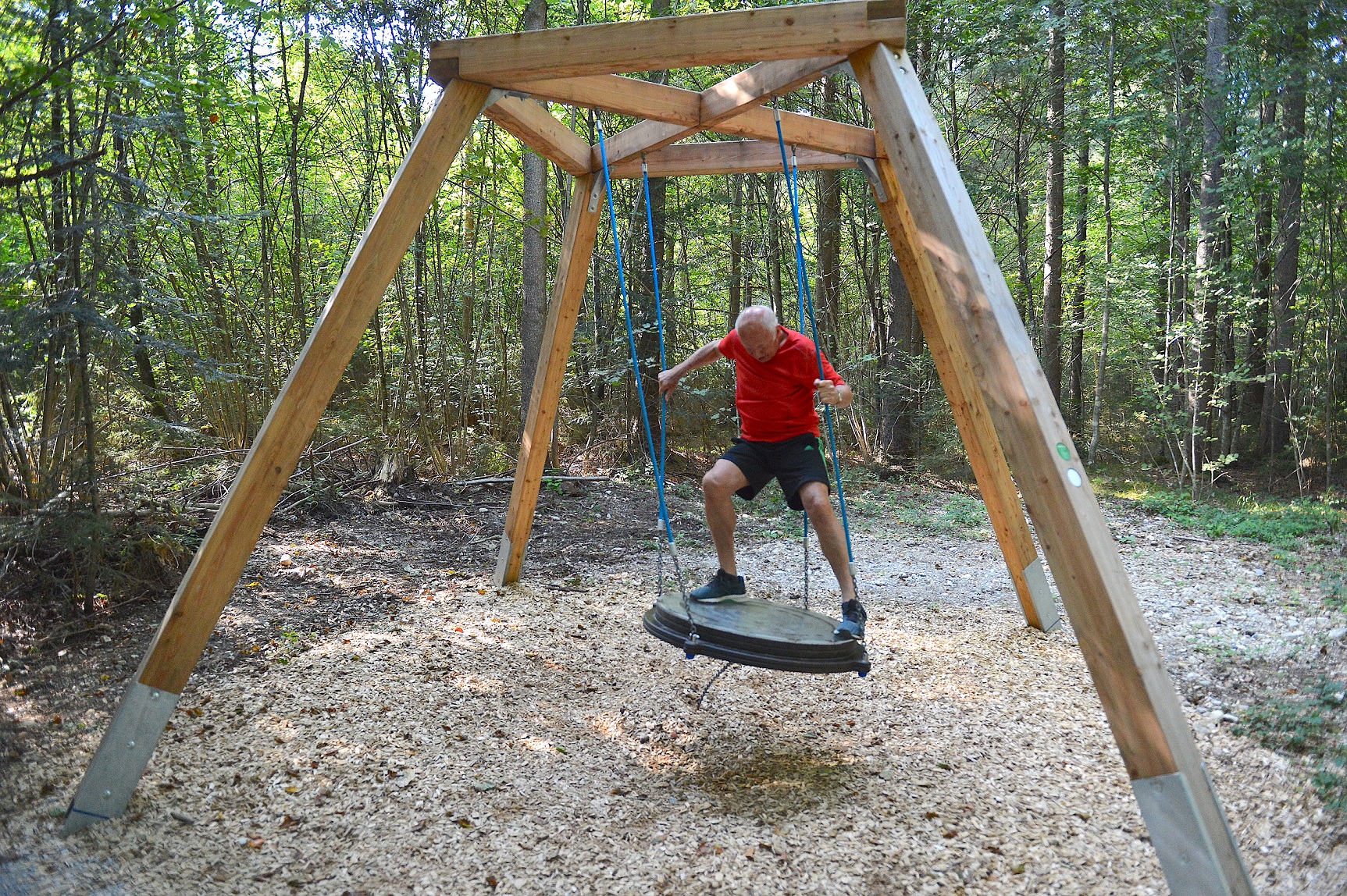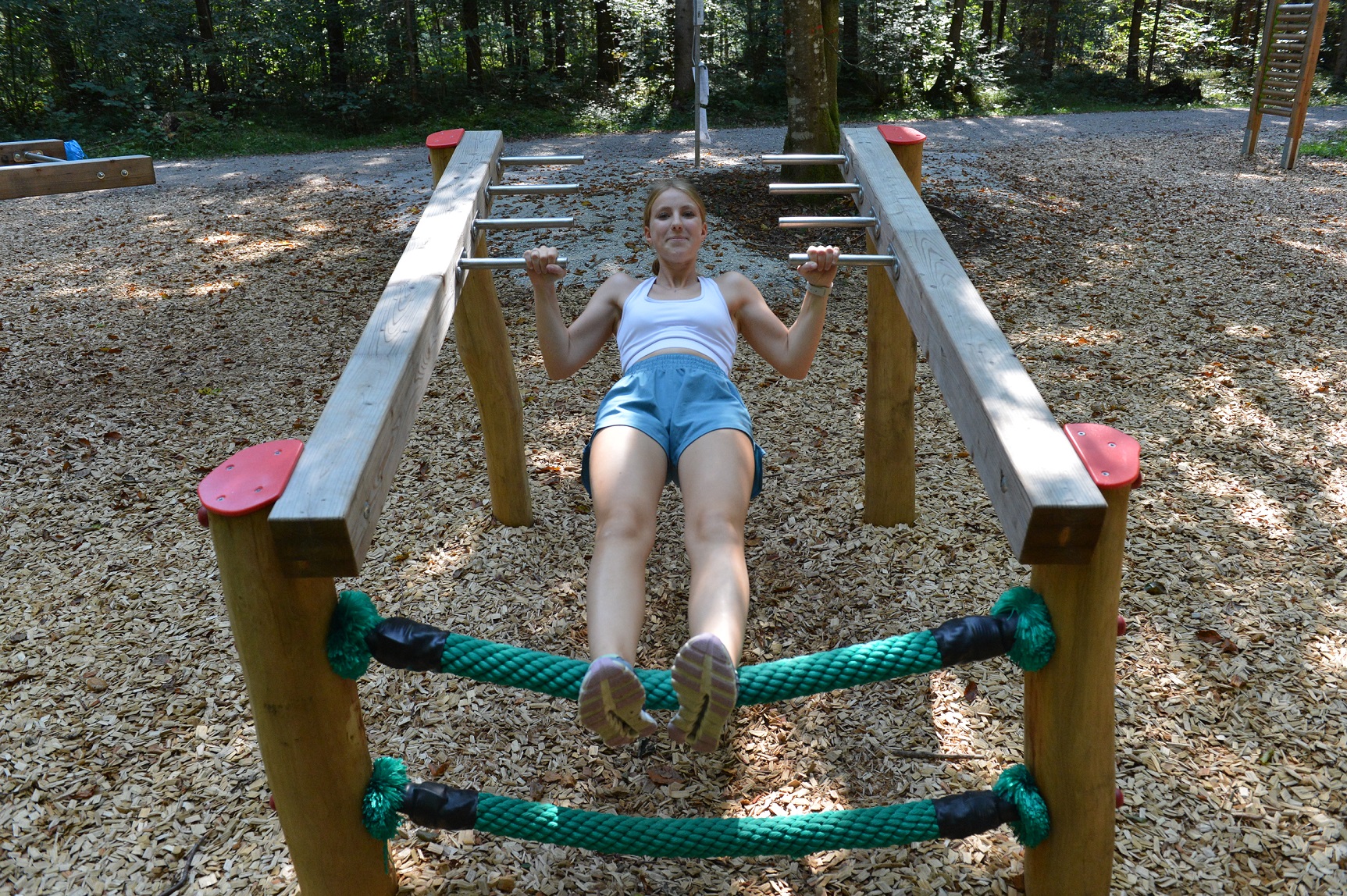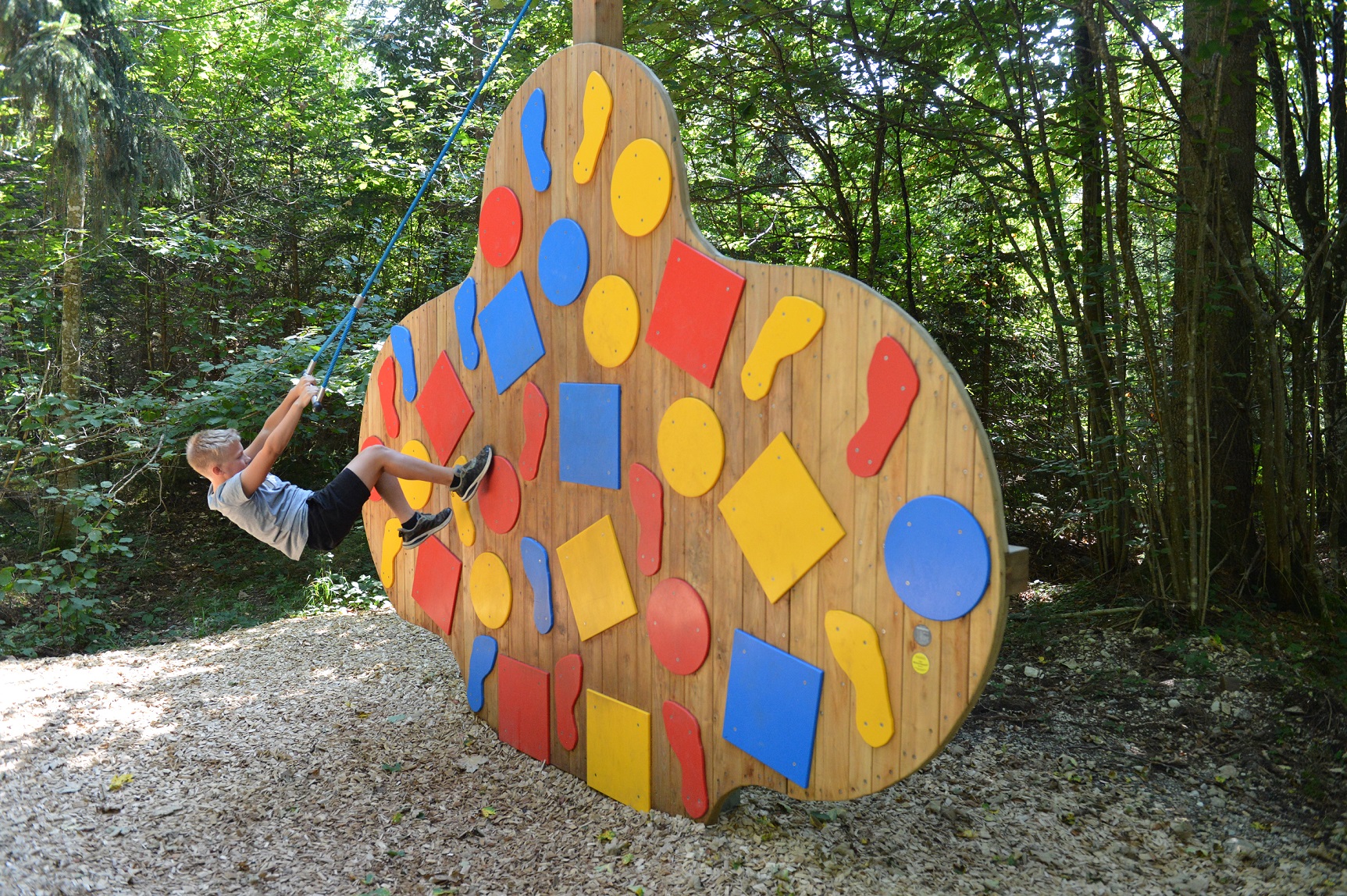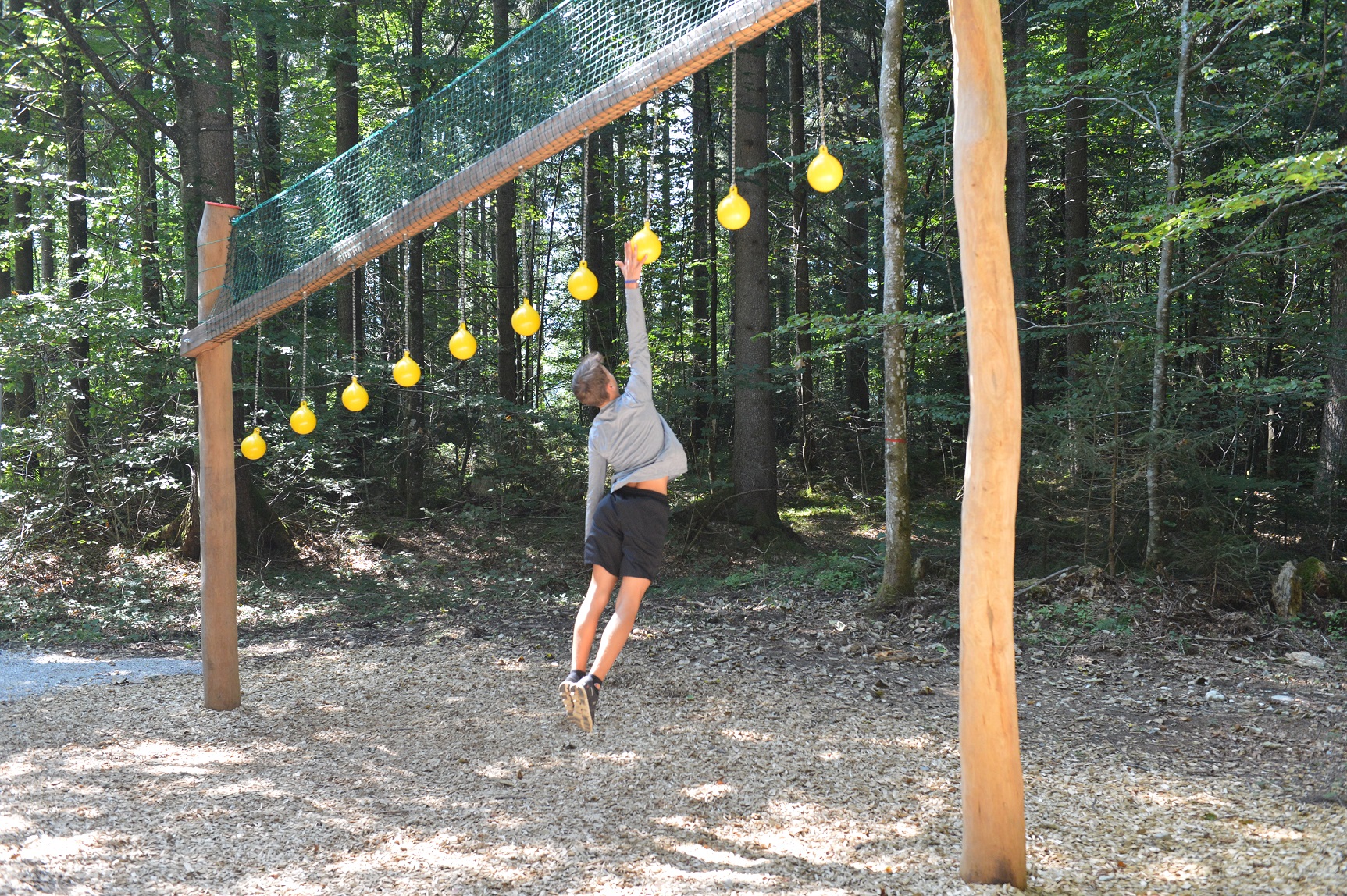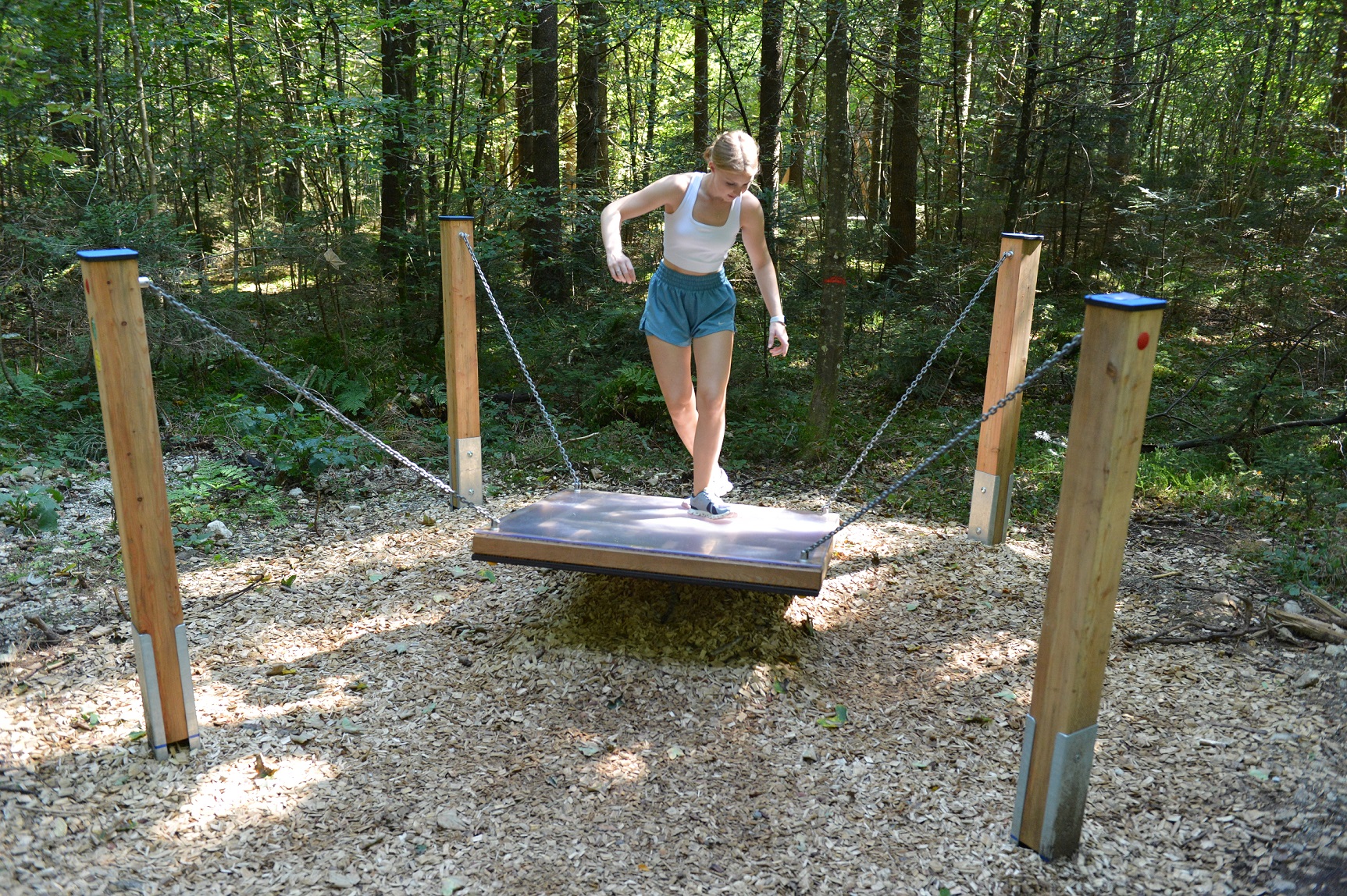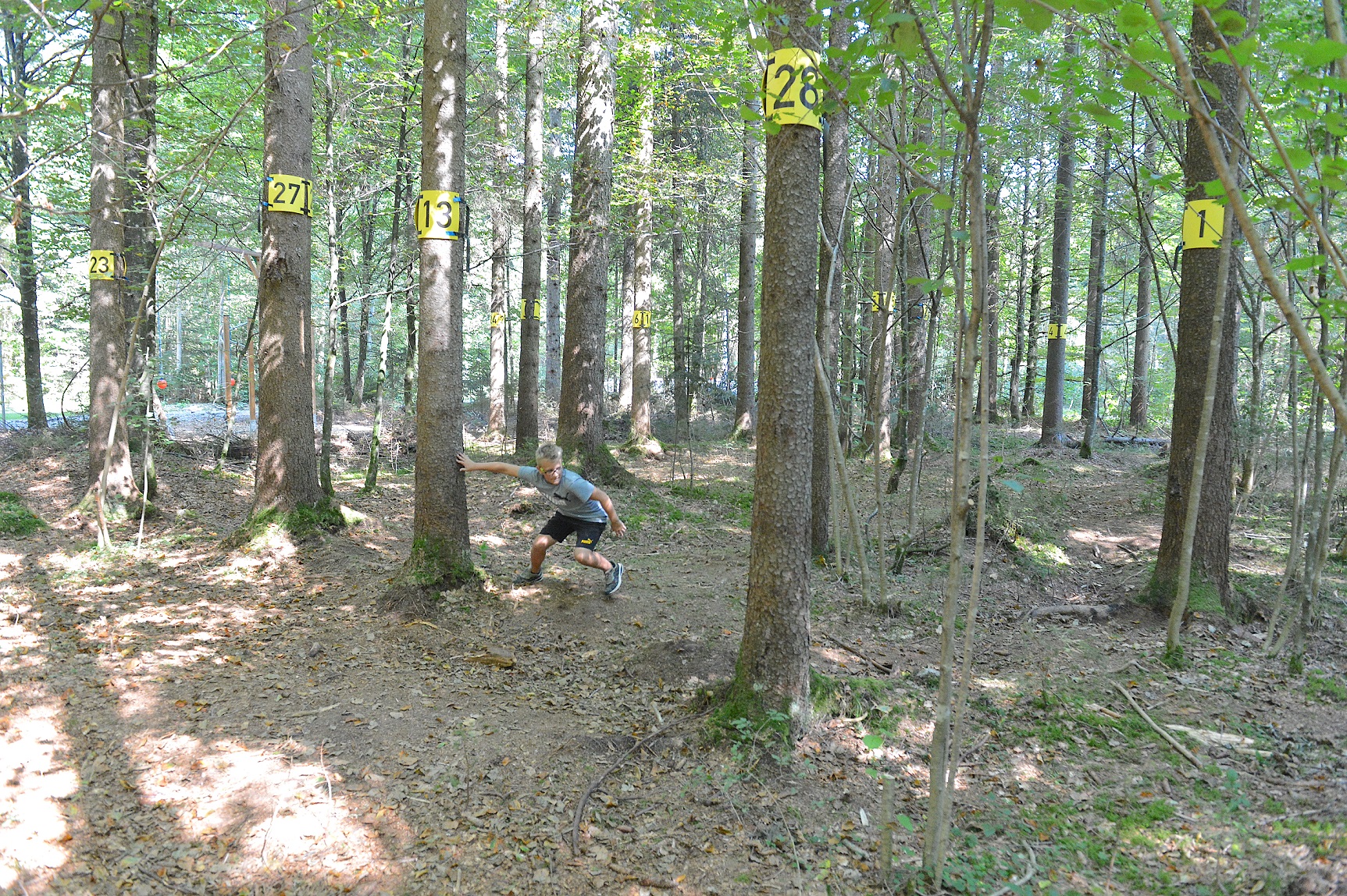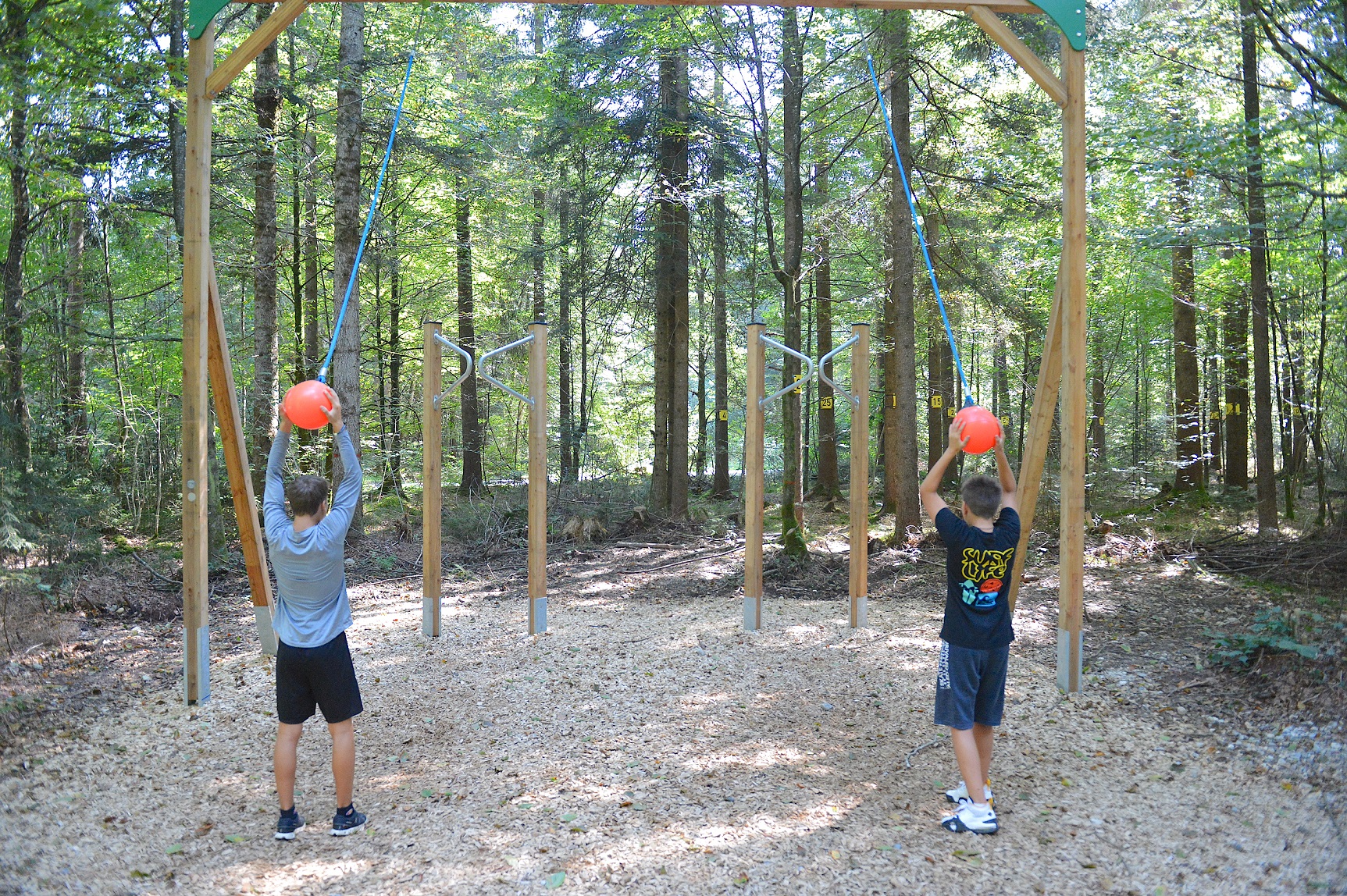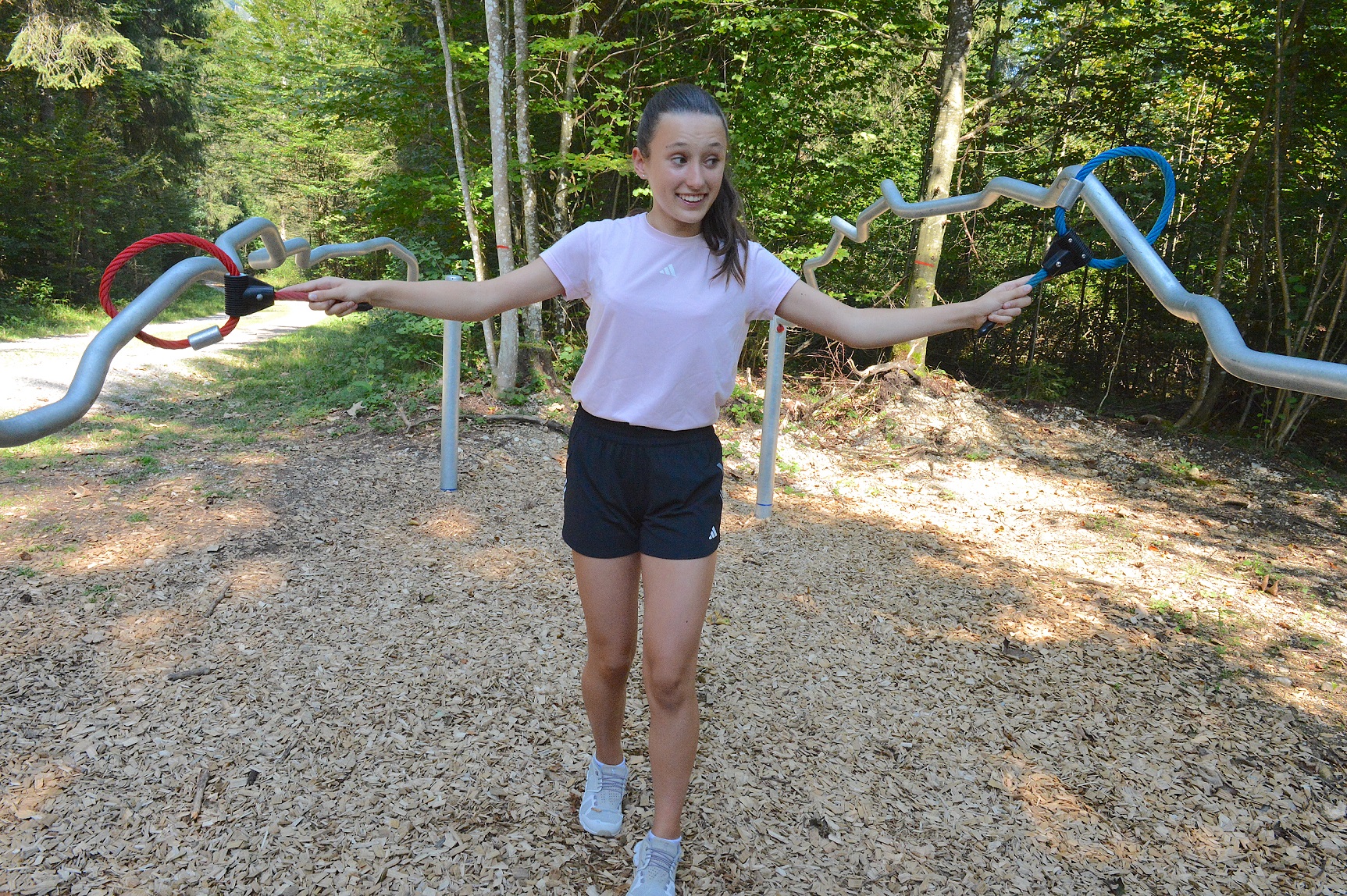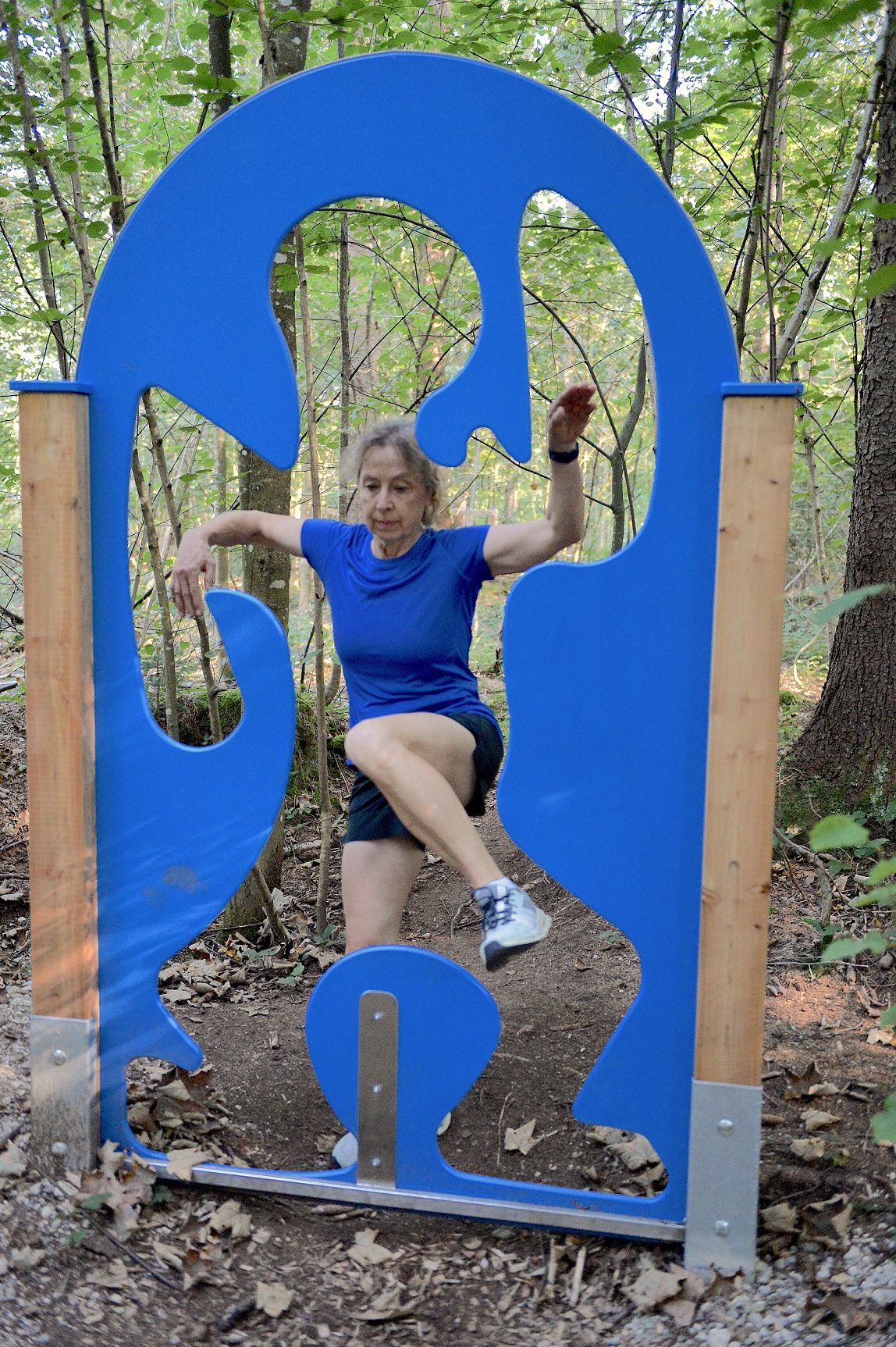01 Different Walking
- Overcome the 7 different 5-meter-long wooden segments with coordinative tasks while walking slowly.
- There are different aims for each leg.
- Place both legs alternately, controlled and precisely in the respective target areas (e.g. tracks, building blocks, footsteps).
- You must be clear about the aim of the exercise before performing a new movement. Where do you put your foot?
- At the beginning: practice the individual tasks with a partner holding your hand if necessary.
- Very important: safety of movement is more important than speed!
- Fix your arms at your hips and cover the distance without balancing with your arms.
- Stabilize your balance by using Nordic walking poles.
- You can coordinate your training by focusing on different areas, e.g. orientation, differentiation, balance, reaction or rhythm.
- Try out static and dynamic balance exercises.
- If you feel confident, you can deliberately let a partner disturb your balance.
- Try closing your eyes briefly in between.
- This exercise improves coordination between your feet and legs.
- You manage to break up established movement patterns.
- This exercise warms up your coordination and stimulates the sensory organs in your feet.
- The exercise helps you to prevent future injuries.
02 Waldslalom
- Warm up by walking or running slowly through the easy forest course.
- You can recognize the course by the coloured slalom poles.
- Slowly increase your walking or running speed from attempt to attempt.
- Be aware of roots as you run.
- Depending on your warm-up and performance level, you can also do the running circuit several times in a row.
- Try completing the course at different speeds.
- Try the forest slalom with arm circles, in a hop run or integrate turns and small jumps.
- Once you have warmed up well: run the course against the clock or race against a partner.
- This exercise is great for warming up.
- You improve your agility (= flexibility), running speed and speed endurance (if you run several laps).
03 Zielfischen (Biathlon 1)
You can use this station, as well as station 19, as an intermediate target station for a biathlon (run with built-in precision tasks).
- Take the long „wooden fishing rod“ or the handle fixed to the long wooden trunk in your hand.
- Now try to move the entire system (handle, curved long wooden pole, wooden weight/pendulum hanging from a rope at the tip) with moderate and small body movements so precisely that you hit the aims (small coloured wooden containers) exactly with the „fishing hook“ or the weight at the end of the rope.
- You have made it when you sink the weight into the recesses provided.
- Make a competition out of it: try to hit several (or all) aims in a row.
- You can also try the exercise with timekeeping.
- Try the exercise with your eyes closed.
- Move the „fishing rod“ with one hand only.
- Try the exercise while standing on one leg.
- Do a squat and try to do the exercise from this position (i.e. above your head).
- This exercise improves your coordination with a focus on „precision“ and „three-dimensional seeing“.
- Target fishing helps you to strengthen your core.
- This exercise also strengthens your stabilising muscles in the foot, leg, shoulder, arm and hand area.
04 Balancierstrecke
- Try to balance in a controlled manner on the narrow or unstable wooden beams, the built-in wobble boards, spring devices, posts, seesaws, ropes and stones.
- Your aim should be to complete the entire course without ‚falling off‘ or with as few ‚mistakes‘ as possible.
- Try to avoid touching the taut rubber cords.
- Important: safety is more important than speed!
- At the beginning: try the single task with a partner holding your hand.
- If you get tired, make sure you take a break or stop balancing.
- Hold your arms at your hips and complete the course without balancing with your arms.
- Try to complete the course sideways or backwards. Or try to complete the course while putting most of the weight on your forefoot or heel.
- You can also build in coordination difficulties yourself by wearing two different shoes.
- You can also include additional tasks. For example, try juggling during the exercise or reduce your sensory perception by closing one eye, for example.
- You can also try the exercise as a partner exercise.
- This exercise improves a wide range of balance and control skills.
- You can further develop your multidimensional coordination skills with the balancing course.
05 Dehnoase
- Stretch loops: You can use these loops to stretch the back of your thighs. Simply rest your leg on a hip-high strap in the back/lower lower leg area.
- Stretching wall: This stretches the front of your thigh by resting your foot on a round bar. Stand with your back to the machine.
- Stretch pentagon: Here you can improve the flexibility of your arm, shoulder and chest muscles. To do this, grasp 2 loops with your hands and build up stretching tension.
- Stretching plank: This exercise stretches the hip flexors and adductors (muscles needed to pull the legs up). (You can see the positions and useful partner support in the photo).
- Rotating discs: Performing this exercise will improve the flexibility of your arm, shoulder and chest muscles. To do this, move the discs in a coordinated manner with outstretched arms.
Stretching loops/stretching wall/stretching pentagon/stretching platform
- Hold the respective stretching position continuously.
- Increase the stretching effect by actively working the muscles of the antagonists (bending forwards more strongly) or by applying pressure from a partner.
- Press consciously against the loops or wood between the stretching phases (approx. 20 seconds) and then take a short relaxation phase.
Rotating discs
- Rotate both discs forwards in opposite directions. Position one arm at the top and one arm at the bottom.
- Rotate both discs backwards in opposite directions. Position one arm at the top and one arm at the bottom.
- Rotate both discs forwards in parallel.
- Rotate both discs backwards in parallel.
- These exercises will improve your general flexibility.
- You help to stretch your muscles during training.
06 Skisimulator (Balancierwerkstatt)
- Climb onto the plate suspended from the 4 chains and the two „skis“ wobbly mounted on it.
- Put weight on each of the two „skis“ with one foot in the centre area.
- Assume different standing, squatting and tilting positions.
- Imitate typical ski movements, e.g. moguls, short and long turns, small jumps, forward and backward positions.
- Do squats in series.
- Try to do balance exercises on the „skis“, e.g. standing on one leg, standing on one leg but in a squat position or alternate the load on your legs from one side to the other and back again.
- Do a self-test or competition: how long can you stay in a deep squat position?
- By switching from one skiing position to the next, you improve your coordination.
- This exercise is the best way to prepare for the winter and ski season.
- The ’ski simulator‘ improves your static and dynamic balance.
- This exercise strengthens your leg extensor muscles and stabilising muscles, especially your ankles and knees.
- The responsiveness of your sensory organs inside the body, especially in the ankle and knee joint area, is improved (= proprioception).
07 Calisthenics-Fächer
- This complex calisthenics machine allows you to train many different strength, climbing, gymnastics and flexibility exercises and a wide variety of load forms.
Here are the most important device modules:
- battle ropes
- sling straps
- pull-up bar
- horizontal bars
- hanging bars
- climbing holds
- climbing bar
- rings
- rope
- parallel bars
- squat ladder
- fascia rol
Various training effects – depending on the exercise.
08 Kletterstrecke
- Climb individual climbing sections or the entire climbing route with or without breaks.
- Choose different routes within the climbing zones.
- Increase your speed and precision (= precise grip positioning).
- Try climbing in unusual positions (e.g. with your back to the wall).
- Try to climb on the ropes and ropes with only 3 limbs (= extremities), e.g. with 2 arms but only 1 leg.
- If you are not travelling alone: Try to climb next to, under or past each other at the same time.
- Solve additional tasks while climbing.
- This exercise improves the coordination of your arms and legs.
- Climbing strengthens the muscles in your fingers, arms, shoulders and torso.
- When using the climbing route, you also improve your sensory system (= absorption of information), in particular your sense of touch and sensation (= tactile stimuli) and your sense of movement, position, position and tension (= kinaesthetic stimuli).
09 Spinnennetz
- Walk, run or jump through the rubber spider web.
- Try not to touch the spider web.
- Consciously lift your knees and feet.
- If you fall and get caught on the strings, try to catch your body with your arms in a controlled manner.
- Find different paths through the given grid spaces.
- Run at different paces and frequencies.
- Try to increase your speed with each run.
- This exercise improves your running coordination and mental anticipation of your future movement sequences (= anticipation).
- When training in the spider web, you strengthen your hip flexors as well as your gluteal and core muscles.
- The training has a positive effect on your speed.
10 Gehirn-Koordination
- Try to rotate several discs simultaneously in different planes and in different directions.
- Use 2 to 4 of your extremities (e.g. arms, legs, head, …) to do this.
- Always find new combinations of discs.
- Try spinning the discs with one or more fingers, your fist, your elbow, the ball of your foot, your heel or your head.
- Try to spin each disc at a different speed.
- Spin a disc with both hands.
- Assume different positions, e.g. standing on your toes, on your side or in a push-up position.
- You can get creative together with a partner – think up your own partner solutions.
- Change your line of vision or head position during the exercise.
- This exercise stimulates your brain to perform unusual complex tasks. This improves your brain performance.
- You improve your arm/leg and left/right coordination.
- Training on this station helps to maintain or even improve the abilities of your muscles and nerves (= neuromuscular performance and neuromuscular competence).
- This station improves your spatial orientation.
- This exercise also serves as a warm-up.
11 Ball-Zielstation
- You see a ball hanging from a rope from a height of a few metres.
- Shoot or throw this ball so that you hit the targets on the trees and posts a few metres away.
- Be sure to watch out for the ball bouncing back.
- Push or throw the ball with both arms.
- Try to kick or throw the ball with one arm only.
- Try to control your strength so that the ball does not hit the target with full force but just barely touches it.
- Try a competition: how many hits can you make in a given time?
- Improve your arm strength with this exercise.
- Your kicking and throwing coordination is improved by training at the ball target station.
12 Kitesurfsimulator
- Pick up the shackle that is attached to the rope.
- Tighten the rope.
- Take a short run-up and circle/swing around/fly around the mast several times.
- Try to increase your flight time or the number of laps. You can do this either by increasing your speed on the run-up or by optimising your hanging position.
- Try to turn along the longitudinal axis of your body in a controlled manner.
- Try out different flying and hanging positions.
- This exercise strengthens your finger, hand, arm and core muscles.
- The kitesurfing simulator helps you to improve your general dexterity (= mobility) with a focus on orientation skills.
13 Hulakubus
- Climb onto the plate suspended from the 4 chains.
- Assume a calm, two-legged standing position in the centre of the plate.
- By rhythmically changing your standing position, the ball in the floor labyrinth should start to vibrate.
- Try to solve the task standing on one leg.
- If you are travelling with a partner: stand on the plate together and try to move the ball.
- You train your coordination and balance and your stabilising muscles, especially your ankles, knees and torso.
- The responsiveness of your sensory organs inside the body, especially in the ankle and knee joint area, is improved (= proprioception).
14 Kraftareal
- Parallel bars: supports, swings, dips, …
- Squat ladder: place the movable ladder on your shoulders and move it up and down with two-legged squats.
- Suspended rowing: arm strength in a horizontal hanging position
- Leg strength on the stone: one-legged jumps from a standing position (= vertical jumps)
- Battle ropes: swing the two ropes rhythmically with your arms.
- Bench press: here you lift a load upwards with your arms while lying down.
- Squat roller wall: lean your back against the rollers while doing squats.
- Here you can do strengthening exercises for the main muscle groups in your body.
- Choose a position or load in which you can perform the exercises several times relatively easily.
- If you can only manage 1 to 3 repetitions or none at all, you should not (yet) use this device.
- The aim should be to do 1 to 3 sets of 6 to 12 repetitions per machine.
- If you have specific aims (e.g. strength endurance, cross-sectional strength, explosive strength, maximum strength, reactive strength), you must observe and implement the necessary intensities and movement speeds.
- Training on this station will improve your strength endurance, muscle cross-section and the explosive and maximum strength of your leg, arm and shoulder muscles (depending on the load level and duration).
15 Wasserskiwand
- Pick up the 3-corner grip attached to the rope hanging from the post.
- Take the handle in your hand and pull the taut rope away from the vertical climbing plate.
- Build up body tension, hold the handle at eye level with the rope taut and apply counter pressure with one foot to the vertical plate at a height of approx. 50 to 70 cm.
- Press the second leg against the plate. Now try to stabilise your whole body with tensed (core) muscles on the rope pulled away from the plate in a strong reclined position (= water ski position).
- In the water ski support/hanging position, carefully try to walk around on the vertical board with your legs.
- There are coloured aims on the board. Step on them with your feet.
- Take small or large steps on the vertical wall.
- Try doing two-legged jumps on the wall.
- Try to move your feet on the wall quickly and with a high frequency (= tapping).
- This machine is a fun way to strengthen your core, shoulders and arms.
- This exercise is good for both your coordination and your agility (= flexibility).
16 Jumping to balls
- You will see small balls hanging from the beam scaffolding at an increasing height.
- Take a few steps with a running jump upwards and try to reach a ball with your arms outstretched.
- How high can you jump? Which ball can you still reach?
- Please only do this exercise if you are already well warmed up.
- Try the exercise with different run-up lengths.
- You can jump with one or both legs.
- Also try to reach the balls with a standing jump.
- This exercise will improve your jumping coordination and your jumping power.
17 Wackellabyrinth (Balancierwerkstatt)
- First climb the labyrinth plate, which is suspended from 4 chains.
- Take a steady, two-legged standing position in the centre of the plate.
- Now change your standing position or shift your body weight so that you can move the ball through the floor labyrinth.
- Try to solve the task in a one-legged stance or in a two-legged squat position.
- If you are travelling with a partner: stand on the plate together and try to move the ball (maximum 2 people).
- Have a competition: how quickly can you complete a round with the ball?
- This exercise improves your coordination, especially your balance.
- Exercising on this station strengthens your stabilising muscles, especially your ankles and knees.
- The responsiveness of your sensory organs inside the body, especially in the ankle and knee joint area, is improved (= proprioception).
18 Orientierungswald
- Walk or run along the 30 trees marked with numbers in the given numerical order.
- Be aware of your path.
- Take into account the shape of the terrain, trees, branches and uneven ground such as roots.
- Die Gesamtstrecke mit 30 Zahlen ist ausdauerorientiert. Wenn du die Übung schnelligkeitsorientiert machen möchtest, teile die Gesamtstrecke in kürzere Teilstrecken (z. B. 1 bis 10, 11 bis 20 und 21 bis 30) und lege eine Strecke z. B. mit höherer Bewegungsintensität oder Schnelligkeit zurück.
- Verändere beim Laufen die Reihenfolge der Nummern, z. B. 3, 5, 9 etc.
- Versuche andere Fortbewegungsformen wie z. B. Hopserlauf.
- Ihr könnt diese Station auch als Paar oder in der Gruppe absolvieren.
- Versucht, die Task in der Gruppe als Menschenschlange zu bewältigen, indem ihr Hand in Hand lauft.
- Diese Übung eignet sich perfekt zum Aufwärmen.
- Im Orientierungswald wird – wie der Name schon sagt – deine Orientierungsfähigkeit verbessert.
- Abhängig von der Dauer und der Intensität, in der du die Übung durchführst, wird auch deine Ausdauer, deine Schnelligkeitsausdauer oder deine generelle Schnelligkeit verbessert.
19 Pendelzielen (Biathlon 2)
You can use this station, as well as station 3, as an intermediate target station for a biathlon (run with built-in precision tasks).
- Try to accelerate the hanging ball in a pendulum motion so that it flies through the narrow space between the 2 V-shaped steel hoops.
- The best way to do this is to push or throw the ball away from you with your arms.
- Move the ball through the bottleneck from the front.
- Try to ensure that the ball only passes through the narrow section when it swings back.
- Try to aim so well that the ball does not touch the steel hoops as it passes through them.
- Make it a competition: A certain number of positive attempts (passing the ball through the narrow section with or without touching it) must be achieved.
- You can include this station as a finish station in a running biathlon.
- This exercise improves your arm strength.
- You improve your kicking and throwing coordination with pendulum aiming.
- Here you train precision performance under conditional pre-load, i.e. after you have already done sports.
20 Wackelplatte (Balancierwerkstatt)
- Step onto the plate suspended on 4 chains.
- Assume a calm, two-legged standing position in the centre of the plate.
- Try to consciously equalise or reduce the vibration of the plate.
- Switch to a one-legged stance.
- Try to transition to the one-legged stance with your eyes closed.
- Duration: with eyes open approx. 20 seconds to 1 minute, with eyes closed approx. 1 to 10 seconds
- Fix your arms at your hips.
- Try to change the position of your head or the direction of your gaze during the exercise.
- Try doing squats while standing on the plate.
- If you are travelling with a partner: stand on the plate together and try to keep your balance as a pair.
- This exercise improves your coordination (balance) and strengthens your stabilising muscles, especially your ankles and knees.
- The responsiveness of your sensory organs inside the body, especially in the ankle and knee joint area, is improved (= proprioception).
21 Heißer Draht
- In front of you are 2 irregularly curved steel pipes (approx. 4 metres long), which are fixed parallel to the ground at a distance of 1.20 metres on 3 supports each.
- In addition, there are hand tools (iron rings with handles) that can wrap around the pipes at a short distance.
- Now try to follow the unrhythmic undulating course of the steel pipes very slowly and precisely with the iron rings in your hand.
- Try to touch the iron bars as little as possible with the two hand tools.
- Try the exercise with 1 or 2 hands and hand devices.
- Have a competition: try to cover the distance with as few touches as possible. Count the touches.
- Or try to complete the entire course as quickly and accurately as possible.
- This exercise improves your coordination with a focus on precision and your peripheral vision (= „seeing out of the corner of your eye“).
- With the „hot wire“ you can strengthen your core and increase your flexibility, as well as strengthening your muscles in the shoulder, arm and hand area.
22 Urwaldweg
- Aim to move (walking or running) along the narrow path between the trees and undergrowth.
- Try to overcome the built-in obstacles (e.g. openings to climb through) as easily as possible and, if possible, without touching them.
- Try the exercise at different speeds.
- Try out different walking variations.
- If you are travelling with a partner or in a group: do the exercise in a line of people, i.e. „hand in hand“.
- Try the task blind, but with a partner holding your hand.
- Go off blind, but let yourself be guided by instructions from a supporting partner.
- This exercise improves your dexterity (= agility).
- It also trains your orientation skills.

